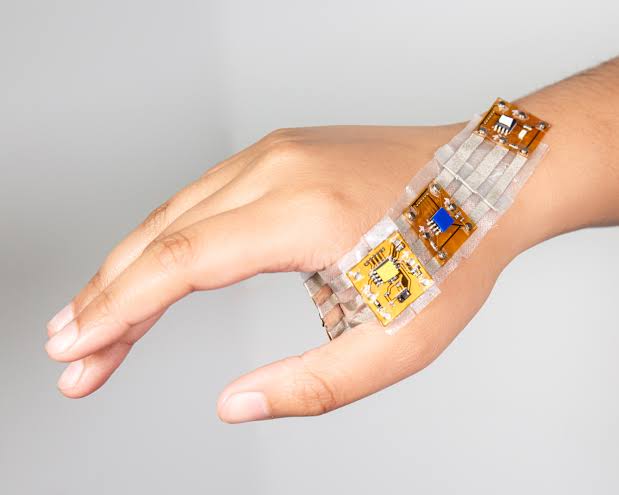
Foldable & Rollable Phones: The Future of Mobile Screens
Foldable and rollable phones represent a new era of mobile screens with flexible displays that expand usability without sacrificing portability. Despite challenges like durability and cost, advancements in materials and software adaptation are driving growth. Leading brands continue innovating, offering users versatile devices that combine compactness with larger screens. This technology is poised to redefine mobile experiences and become mainstream in the near future.
✨ Raghav Jain

Introduction
Wearable technology has transformed how we interact with the world, blending convenience, health tracking, and connectivity into everyday accessories. The first generation of wearables like fitness bands and smartwatches paved the way for more advanced, discreet, and innovative devices. Today, next-gen wearables are evolving beyond bulky gadgets into sleek smart rings, flexible patches, and even smart tattoos. These futuristic devices promise to seamlessly integrate with our bodies, offering real-time data, personalized health insights, and enhanced communication without compromising style or comfort.
In this article, we’ll explore the exciting world of next-gen wearables, their technology, applications, and how they’re reshaping the future of personal technology. Foldable and rollable phones represent the next frontier in smartphone innovation, blending cutting-edge display technology with futuristic design to redefine how we interact with our devices. Unlike traditional rigid screens, these next-generation smartphones feature flexible displays that can bend, fold, or even roll out to transform from a compact phone into a tablet-sized screen—or vice versa—offering unprecedented versatility. Companies like Samsung, Huawei, Motorola, and Oppo have already launched foldable models, while brands like LG (before exiting the smartphone market) and TCL have showcased rollable prototypes, signaling a shift toward adaptable form factors. This evolution is driven by advancements in flexible OLED panels, ultra-thin glass, and hinge mechanisms, enabling screens to withstand hundreds of thousands of folds without cracking. Beyond the "wow" factor, these devices address a growing demand for larger screens without sacrificing portability, merging the convenience of a smartphone with the productivity of a tablet.
One of the biggest appeals of foldable phones is their dual-screen functionality. Devices like the Samsung Galaxy Z Fold series unfold into mini-tablets, ideal for multitasking, gaming, or watching videos, while the Motorola Razr revives the flip-phone nostalgia with a compact foldable design. Meanwhile, rollable concepts take flexibility further—imagine a phone that expands from 6 inches to 10 inches with a simple slide, like LG’s Rollable (canceled) or TCL’s sliding display prototypes. These innovations aren’t just gimmicks; they solve real-world problems, such as reducing the need to carry multiple devices or struggling with cramped screens for work or media consumption.
However, the journey to perfecting foldable and rollable tech hasn’t been smooth. Early models faced criticism for durability issues, creased screens, and high prices. Samsung’s first Galaxy Fold, for instance, had a rocky launch due to screens breaking from debris or improper handling. But rapid improvements—like sweeper mechanisms to block dust, stronger ultra-thin glass (UTG), and redesigned hinges—have made newer iterations far more resilient. The Galaxy Z Fold 5 and Flip 5 now feature water resistance and smoother folding, while Google and OnePlus have entered the market, signaling industry-wide confidence in the category.
Price remains a hurdle, with foldables often costing $1,500–$2,000, but as production scales and competition grows, costs are expected to drop. Analysts predict foldables will make up 35% of the premium smartphone market by 2027, with rollables following as tech matures. Developers are also adapting apps for these form factors; Android now natively supports multi-window modes and screen continuity, ensuring seamless transitions between folded and unfolded states.
Looking ahead, the potential extends beyond phones. Foldable tablets, rollable TVs, and even wearable screens could emerge, revolutionizing everything from entertainment to workplace tools. Imagine a laptop-sized display that rolls into your pocket or a smartwatch with a stretchable screen. Challenges like battery flexibility and software optimization remain, but with tech giants and startups investing heavily, the era of rigid screens may soon feel obsolete.
In a world craving innovation, foldable and rollable phones aren’t just a trend—they’re a glimpse into a future where devices adapt to us, not the other way around. As materials improve and prices drop, these flexible screens could become the new standard, making today’s slab smartphones look as outdated as the flip phones of the early 2000s. The future of mobile screens isn’t flat—it’s foldable, rollable, and full of possibilities.
Understanding Next-Gen Wearables
Next-gen wearables refer to the latest advancements in wearable technology that go beyond traditional wristbands or watches. These devices focus on miniaturization, flexibility, and biocompatibility to deliver enhanced functionality in subtle and innovative forms.
Common types include:
- Smart Rings: Small, multifunctional devices worn on fingers.
- Smart Tattoos: Temporary or permanent electronic tattoos that monitor health.
- Flexible Patches: Thin, skin-adherent sensors tracking vitals.
- Implantables: Devices implanted under the skin for continuous monitoring.
These wearables aim to provide continuous data collection and user interaction without interrupting daily life or requiring bulky equipment.
Smart Rings: Small But Powerful
Smart rings are compact wearable devices that combine style with technology.
1. Health Monitoring
Many smart rings track heart rate, sleep patterns, oxygen levels, and activity metrics just like smartwatches but in a more discreet way.
2. Contactless Payments and Authentication
Some smart rings support NFC technology, allowing users to make payments or unlock devices with a simple tap.
3. Notifications and Alerts
Rings can vibrate or light up to notify users of calls, messages, or calendar reminders without pulling out a phone.
4. Battery Life and Comfort
Due to their small size, smart rings boast longer battery life and are lightweight, making them comfortable for 24/7 wear.
Smart Tattoos: The Future of Wearable Electronics
Smart tattoos are ultra-thin electronic devices printed or embedded onto the skin.
1. Continuous Health Tracking
These tattoos can monitor vital signs such as hydration, body temperature, glucose levels, and even UV exposure in real time.
2. Flexible and Biocompatible
Made from flexible, stretchable materials, smart tattoos move naturally with the skin without irritation.
3. Temporary or Permanent
Some smart tattoos last only a few days or weeks, while research is underway for longer-lasting, implantable versions.
4. Data Transmission
Smart tattoos connect wirelessly to smartphones or other devices, providing seamless health insights.
Flexible Patches and Implantables
Beyond rings and tattoos, other next-gen wearables include:
Flexible Patches
Skin patches embedded with sensors monitor heart rate variability, hydration, or muscle activity during workouts or medical treatment.
Implantables
Tiny devices placed beneath the skin enable continuous glucose monitoring for diabetics or track other chronic conditions.
Both options offer highly accurate data collection and minimal user interference.
Advantages of Next-Gen Wearables
1. Discreet and Comfortable
Unlike bulky devices, these wearables blend with daily life, offering comfort and style without compromise.
2. Continuous and Real-Time Data
Constant monitoring enables early detection of health issues and personalized wellness insights.
3. Enhanced User Engagement
Smart rings or tattoos provide subtle notifications and feedback, reducing screen time and distractions.
4. Integration with Smart Ecosystems
These devices connect with smartphones, smart homes, and health apps to create comprehensive personal tech ecosystems.
Challenges and Considerations
1. Battery and Power
Miniaturization limits battery size. Researchers are exploring wireless charging and energy harvesting to extend usage.
2. Data Privacy and Security
Continuous data collection raises privacy concerns that require robust encryption and user control.
3. Durability and Skin Compatibility
Devices must withstand daily wear, sweat, and movement without causing irritation or damage.
4. Cost and Accessibility
Advanced materials and technology currently make these wearables expensive and less accessible.
Real-World Applications
- Health & Fitness: Continuous glucose monitoring, hydration tracking, stress detection, and sleep analysis.
- Medical: Early detection of diseases, remote patient monitoring, drug delivery systems.
- Lifestyle: Contactless payments, gesture controls, smartphone notifications without screens.
- Sports & Performance: Muscle fatigue monitoring, hydration alerts, recovery optimization.
Daily Integration Tips
Morning Start
Wear your smart ring or apply your flexible patch to begin real-time tracking from the day’s start.
During the Day
Use smart tattoos for hydration reminders and UV exposure alerts during outdoor activities.
Evening Review
Check health data summaries on your smartphone or paired device to understand sleep quality and stress levels.
Myths About Next-Gen Wearables: Debunked
“Smart tattoos are permanent and painful.”
→ Most are temporary and painless to apply.
“Smart rings have limited functions.”
→ They can monitor multiple health metrics and support payments.
“Implantables are only for sick people.”
→ Implantables also help athletes and wellness enthusiasts track performance.
“Next-gen wearables are just a fad.”
→ Growing research and adoption show they are the future of personalized tech.
Sample Next-Gen Wearable Routine
Morning
Wear your smart ring while having breakfast. Use a flexible patch if needed.
Daytime
Stay active and track vitals via your tattoo sensor or patch.
Evening
Review your collected data. Charge devices if needed.
Weekly
Consult your health apps for trends and adjust lifestyle accordingly.
Conclusion
Next-generation wearables like smart rings and smart tattoos are revolutionizing personal technology by offering discreet, continuous, and real-time monitoring in forms that blend naturally with the body. These innovations promise to enhance health tracking, communication, and convenience without the bulk of traditional devices.
Whether you seek to optimize fitness, monitor health, or stay connected effortlessly, next-gen wearables provide a glimpse into the future where technology and the human body merge seamlessly. Embracing these advancements today means stepping into a smarter, healthier tomorrow.
Start exploring next-gen wearables and experience how technology can become truly personal.
Q&A Section
Q1: What are foldable phones?
Ans: Foldable phones have flexible screens that can bend or fold, allowing the device to switch between phone and tablet modes.
Q2: How do rollable phones differ from foldable phones?
Ans: Rollable phones feature screens that extend by rolling out horizontally or vertically, rather than folding along a hinge.
Q3: What materials enable foldable and rollable phone screens?
Ans: These phones use flexible OLED or AMOLED display technology combined with ultra-thin glass or plastic substrates.
Q4: What are the main advantages of foldable and rollable phones?
Ans: They offer larger screen sizes in a compact form, improving multitasking, media consumption, and portability.
Q5: What challenges do foldable and rollable phones currently face?
Ans: Durability, high manufacturing costs, crease visibility, and software optimization remain key challenges.
Q6: How does software adapt to foldable and rollable screens?
Ans: Operating systems and apps are designed to smoothly transition UI layouts as the screen size changes dynamically.
Q7: Are foldable and rollable phones more expensive than regular smartphones?
Ans: Yes, due to advanced materials and complex engineering, these devices usually come with premium price tags.
Q8: Which brands are leading in foldable and rollable phone technology?
Ans: Samsung, LG, Oppo, and TCL are some pioneers actively developing and releasing these devices.
Q9: How do foldable phones impact user experience?
Ans: They enhance productivity and entertainment by offering versatile screen sizes and improved multitasking.
Q10: What is the future outlook for foldable and rollable phones?
Ans: As technology matures, these phones are expected to become more affordable, durable, and widely adopted.
Similar Articles
Find more relatable content in similar Articles

How Wearable Devices Detect Hu..
Wearable devices use biosenso.. Read More

Hyperloop Technology: A Game-..
Hyperloop technology envision.. Read More

The Role of AI Facial Recognit..
AI facial recognition is revo.. Read More

Latest Dermatology Devices En..
The latest dermatology device.. Read More
Explore Other Categories
Explore many different categories of articles ranging from Gadgets to Security
Smart Devices, Gear & Innovations
Discover in-depth reviews, hands-on experiences, and expert insights on the newest gadgets—from smartphones to smartwatches, headphones, wearables, and everything in between. Stay ahead with the latest in tech gear
Apps That Power Your World
Explore essential mobile and desktop applications across all platforms. From productivity boosters to creative tools, we cover updates, recommendations, and how-tos to make your digital life easier and more efficient.
Tomorrow's Technology, Today's Insights
Dive into the world of emerging technologies, AI breakthroughs, space tech, robotics, and innovations shaping the future. Stay informed on what's next in the evolution of science and technology.
Protecting You in a Digital Age
Learn how to secure your data, protect your privacy, and understand the latest in online threats. We break down complex cybersecurity topics into practical advice for everyday users and professionals alike.
© 2025 Copyrights by rTechnology. All Rights Reserved.